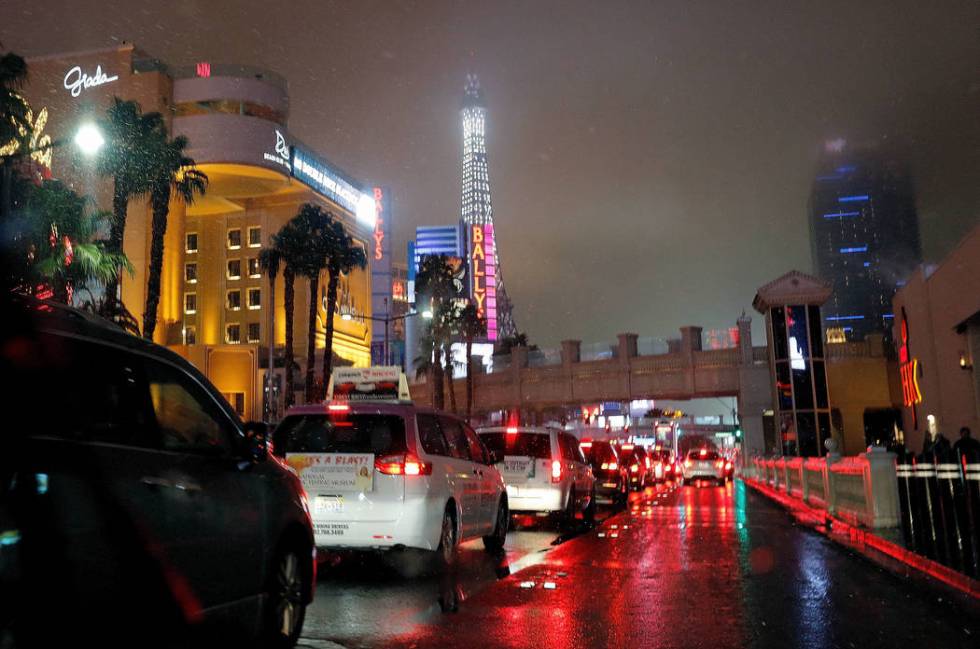Is rail-based transportation a viable option for Las Vegas Strip?

Will the Las Vegas Strip be the next major corridor in the valley to see steel put in the ground for its transportation needs?
Despite the obvious issues that may create — limiting a lane of traffic in each direction of the already busy resort corridor — transportation officials are examining every option for the area’s cash cow.
Within the next 10 years, transportation officials say, at least one alternative mode of transportation will be needed to link visitors between McCarran International Airport, the Las Vegas Strip and downtown Las Vegas.
To address that need, the Regional Transportation Commission of Southern Nevada, with the help of civil engineer group Louis Berger, commissioned the Resort Corridor Feasibility study.
“Everyone recognizes the need to increase capacity for movement within the resort corridor,” said David Swallow, senior director of engineering and technology for the commission. “Realistically, nobody envisions widening Las Vegas Boulevard any further, so you have to look at other approaches.”
The commission looked at nine transit technologies, including everything from buses and people movers to light rail and gondolas. Yes, gondolas.
After reviewing each of the options, the RTC, working with the Las Vegas Convention and Visitors Authority and the resort industry, came up with the two preferred options: an expanded RTC bus service and a European tram option.
The European tram is looked at as more of a long-term possibility. The system would feature a dedicated lane on each side, with rail track running from the airport to downtown Las Vegas.
A European tram differs from light rail by not requiring the addition of overhead wires to power the rail cars. Instead, a third rail on the ground would power the tram via electricity, Swallow said.
Having something as noticeable as a tram on the Strip would prove to be attractive to visitors, just as the Duece — double decker bus service — is popular among tourists. Swallow believes the tram would yield similar results.
“There’s nothing that beats having transit right front and center on the Las Vegas Strip,” he said.
The tram could work in a mixed-flow lane, feature faster boarding than a bus and have higher capacity than a bus, with up to 220 passengers per tram.
The tram’s drawback was high capital cost, construction of track required and the lack of maneuverability in traffic, which could lead to being slowed by congestion.
A restructured Strip &Downtown Express (SDX) bus route would be altered to have a direct transit link between the airport and the Strip.
The service is quicker than traditional bus service, as it features fewer stops, it’s maneuverable in traffic and no construction is required.
Drawbacks of the SDX are lower capacity compared to the European tram (up to 108 passengers) and slow boarding when Deuce buses are used.
With several major projects in Southern Nevada set to be completed in the next few years, including the Las Vegas stadium, MSG Sphere arena, the Las Vegas Convention Center expansion and Resorts World, the demand for mass transit will increase even further.
Those additions and other factors will help increase visitation from 2020’s projected 44 million visitors to 56 million visitors in 2040, according to projections provided by the LVCVA and Applied Analysis.
With the expected growth, Steve Hill, CEO of the LVCVA, said the need is there to institute a plan sooner, rather than later.
“The demand is high now, and certainly time is an issue,” Hill said. “Alternative forms of transportation are great, and when they’re expensive, we need to make sure they’re the right ones and we considered what the options are.”
Though he sees the benefit of the tram, Hill said with emerging technologies set to become more common on the roads, he doesn’t think it is the most logical choice for any community, let alone the Strip.
“I think that putting steel in the ground for transportation purposes is probably something most communities won’t do going forward and won’t need to,” he said. “Autonomous vehicles and those kinds of things eliminate the need for steel.”
No matter what mode is chosen, Clark County Commission Chairwoman Marilyn Kirkpatrick agrees a new option is needed. She hopes having two county commissioners on the RTC board will yield the best option not only for riders, but for the pocketbook as well.
“It is always good to examine alternative transportation options for our resort corridor,” Kirkpatrick said. “With two of our commissioners on the RTC board, I am confident there will be a thorough and lively discussion about what is best for our community and what will give us the best return on our investment.”
Questions and comments should be sent to roadwarrior@reviewjournal.com. Please include your phone number. Follow @RJroadwarrior on Twitter.